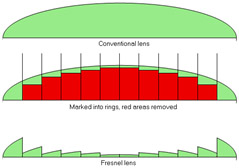 Nowadays, we are more aware that most of our energy sources are limited, therefore we have to use our energy resources efficiently. Solar panels are becoming more popular when it comes to managing the energy consumption and reducing the energy footprint of the earth. In the International Year of Light it is important that everyone becomes aware of the problems that we face.
Nowadays, we are more aware that most of our energy sources are limited, therefore we have to use our energy resources efficiently. Solar panels are becoming more popular when it comes to managing the energy consumption and reducing the energy footprint of the earth. In the International Year of Light it is important that everyone becomes aware of the problems that we face.
By making use of concentrated photovoltaics in combination with printed optics, energy collection will become more efficient. By tailoring the optic, to maximize the light collection, solar panels could be used more efficiently. Concentrated photovoltaics will become the standard for the years to come. But what are Concentrated photovoltaics and what type of optics are used?
What type of optics are used in concentrated photovoltaics
If you make use of Solar panels you would like the energy to be collected highly efficient. In this way, you will maximize the energy that is collected. There are different technologies to concentrate the light efficiently when used in Concentrated photovoltaics. Some examples of concentrator technologies are fresnel lenses and parabolic mirrors. However customized optics like freeform lenses are becoming more popular when it comes to efficient distribution and collection of the light.
Fresnel Lens: suitable for concentrated photovoltaics
Fresnel lenses are used in a variety of applications. Basically, it is a special type of convex lens, with small steps on the optical surface. These sections on the lense have different angles in order to guide the light. Normally when you would like to collect large volumes of light efficiently a normal standardized lens would be really big, in order to be sufficient. The space available in Concentrated photovoltaics is limited, so a standardized lense is no option.
By implementing a fresnel lens in your solar panel you need less volume, which reduces the weight and thickness significantly.
Collection of light in photovoltaics
Due to the sections or small steps on the lens you are able to achieve a shorter focus length without a large size optic. Fresnel lenses have the ability to collect a lot of sunlight and concentrate this on one single point. In case of solar panels, the rays could be guided on the solar cell to maximize the collection of light. Besides customized fresnel lenses, 3D printing allows you to dive into the world of freeform optics.
Light collection with freeform optics
When making use of a 3D printer in optics manufacturing, freeform optics can be implemented in your photovoltaics project. Freeform optics are optics without a specific shape, the whole optic can be customized and optimized in order to collect the light efficiently. Testing your freeform optics is more affordable with printed optics. Other manufacturing methods need expensive tooling in order to create a customized freeform optic. With freeform optics you are able to tailor your optic in a way that it will collect and distribute the sunlight onto the solar cell. The result, a highly efficient light collection And the ability to test your lens design, and your systems efficiency, before moving into tooling or glass optics.
Other types of light collection
Another option to collect the sunlight is by making use of parabolic mirrors. The incoming light is reflected by using mirrors. Exactly in the middle, the light beams hit the solar cell. The main downside of making use of parabolic mirrors is that losses will occur and it is not highly efficient. In this way, collection sun light for solar is more efficient when you use a customized optics.
Customized optics for concentrated photovoltaics
Customization of optics is costly, time-consuming and inflexible with traditional manufacturing methods. However, with the use of 3D printing technologies, customizing your product is possible and your optic will be printed in days. This flexible way of optics manufacturing could be applicable in concentrated photovoltaics. When you make use of printed optics in your solar panel, the collection of light can be specifically managed. If you customize your optic you maximize the efficiency of your concentrated photovoltaic. Customized optics allows you to place the light extremely precise onto the solar cell. This results in highly efficient photovoltaics without making use of large optics or expensive tooling in order to manufacture your optic. Iterations can be easily managed, so if you would like to test several prototypes of your optic, simply upload another CAD-file and print several prototypes within days.
Benefits of printed optics for concentrated photovoltaics
When it comes to the collection of light in concentrated photovoltaics an uniform illumination is desirable in order to collect the light efficiently. By making use of printed optics designers are able to design and prototype lens arrays with a high number of lenslets. By uploading your CAD-file onto our website, your prototype will be ready in 10 working days. Prototyping your optical design allows you to test and explore optical solutions for the efficient collection of light. By making use of our 3D printing service iterations and flexibility are the main benefits for your concentrated photovoltaics project.
www.luxexcel.com
























































































